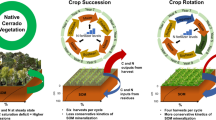Abstract
Nutrient levels, soil moisture and soil organic matter were monitored monthly during a three year period in a site cleared for shifting agriculture (milpa) and in adjacement undisturbed high bush forest soils in Belize. Throughout the study there was no evidence of a decline in available nutrient levels in the cleared site. Sharp changes in P and Mn were considered indicative of wetting and drying periods.
Corn yields for the rainy season crop in the first two years were average for the region ca 2500 kg ha−1 dry wt, but declined dramatically in the third year. Total weed biomass for the rainy season crop conversely increased every year and reduced grain yield probably through competition for nutrients (especially N), light and water. Substantial amounts of nutrients were also immobilized in the weed biomass, which served the agroecological purpose of preventing nutrient loss by leaching.
Similar content being viewed by others
References
Alteri M A and Doll J D 1978 The potential of allelopathy and a tool for weed management in crop fields. PANS 24(4), 495–502.
Arnason J T, Lambert J D H, Gale J, Cal J and Vernon H 1982 Decline of soil fertility due to intensitication of land use by shifting agriculturalists in Belize, C.A. Agro-Ecostystems 8, 27–37.
Baker H G 1974 The evolution of weeds.In R.F. Johnstonet al., eds. Ann. Rev. Ecol and Syst.
Brady N C 1974 The nature and properties of soils. 8th Edit. MacMillan Pub. Co.
Chacon J C and Gliessman S R 1982 The use of the ‘non-weed’ concept in traditional tropical agroecosystems in Southeastern Mexico. Agro-Ecostystems 8, 1–12.
Cowgill U M 1972 An agricultural study of the southern Maya Lowlands. Am. Anthrop. 64, 273–286.
Cunningham R K 1963 The effect of clearing a tropical forest soil. J. Soil Sci. 14, 334–345.
Ewell J, Berish C, Brown B, Price N, and Raich J 1981 Slash and burn impacts on a Costa Rican wet forest site. Ecology 62, 816–829.
Eussen J H H 1982 The ecology of pests: Weeds. Prot. Ecol. 413, 213–222.
Greenland D J and Nye P H 1959 Increase in the carbon and nitrogen contents of tropical soils under natural fallows. J. Soil Sci. 9, 284–299.
Harcombe P A 1975 Nutrient accumulation by vegetation during the first year of recovery of a tropical forest ecosystem.In Recovery and Restoration of Damaged Ecosystems. I. Eds Cairnset al., Univ. of Viginia Press, Charlottsville.
Harcombe P A 1980 Soil nutrient loss as a factor in early tropical secodary succession. Biotrpica 12, (Supplement), 8–14.
Jordon C, Caskey W, Escalante G, Herrera R, Montagninin F, Todd R, and Uhl C 1983 Nitrogen dynamics during conversion of primary Amazonian rain forest to slash and burn agriculture. Oikos 40, 131–139.
Kellman M 1980 Geographic Patterning in Tropical Weed Communities and Early Secondary Succession. Biotrpica 12 (Supplement), 34–39.
Lambert J D H and Arnason J T 1978 Distribution of vegetation on Maya ruins and its relationship to ancient land-use at Lamanai, Belize. Turrialba 28, 33–41.
Lambert J D H, Arnason J T and Gale J L 1980 Leaf litter and changing nutrient levels in a seasonally dry tropical hardwood forest. Belize, C. A. Plant and Soil 55, 429–443.
Lambert J D H and Arnason J T 1982 Traditional Milpa Agriculture in Belize. Inst. Int. Dev. Co-op. University of Ottawa.
Lambert J D H and Arnason J T 1984 Ancient Maya Land-use and Potential Agricultural Productivity at Lamanai, Belize, C.A.In Drained Fields in the Americas. Ed. J P Darch. BAR Int. Series 189: 111–122.
Lindsay W L and Norvell W A 1969 Equilibrium relationships of Zn2+, Fe0+, Ca2+ and H+ with EDTA and DPTA in soils. Soil Sci. Soc. Am. Proc. 33, 62–68.
McKeague J E (Ed) 1978 Manual on sampling and methods of analysis. Subcommittee on methods of analysis. Canadian Soil Survey Comm., Ottawa.
MacArthur R H and Wilson E O 1969 The Theory of Island Biogeography. Princeton Univ. Press.
Mehra O P and Jackson M L 1960 Iron oxide removal from soils and clays in dithionitecitrate system buffered with sodium bicarbonate. 7th Natl. Conf. Clays and Clay Minerals pp 317–327.
Moody K 1978 Crop-weed competition. Philipp. J. Weed Sci. 5, 28–43.
Newbould P J 1970 Methods for evaluation of primary productivity. I.B.P. Handbook #2. Blackwell.
Nye P H and Greenland D J 1960 The soil under shifting cultivation. Tech. Comm. 51, Commonwealth Ag. Bur.
Rappaport R A 1971 The flow of energy in an agricultural Society. Scien. Am. 225, 116–132.
Russell E W 1976 Soil conditions and plant growth. 10th Edit., Longmans.
Sanchez P A 1976 Properties and management of soil in the tropics. John Wiley and Sons.
Sanchez P A, Bandy D E, Villachia J H and Nicholaides J J 1982 Amazon Basin Soils: Management for Continuous Crop Production. Science 216, 821–827.
Sheldrich B H 1984 Analytical Methods Manual 1984. LRRI_Contrib. No. 84-30. Research Board Agriculture Canada.
Snedaker S C 1980 Successional immobilization of nutrients and biologically mediated recycling in tropical forests. Biotropica 12 (Supplement), 16–22.
Toky O P and Ramakrishhnan R S 1981 Cropping and yields in agricultural systems of the northeastern hill region of India. Agro-Ecosystems 7, 11–25.
Turner F T and Gilliam J W 1976 Increased P diffusion as an explanation of increased P availability in flooded rice soil. Plant and Soil 45, 365–377.
Uhl C and Jordon C F 1984 Succession and nutrient dynamics following forest cutting and burning in Amazonia. Ecology 65, 1456–1490.
Young J A and Evans R A 1976 Responses of weed populations to humans. Weed Sci. 24, 186–190.
Zandstra B H and Motooka P S 1978 Beneficial effects of weeds in pest management — a review. PANS 24, 333–338.
Author information
Authors and Affiliations
Rights and permissions
About this article
Cite this article
Lambert, J.D.H., Arnason, J.T. Nutrient dynamics in milpa agriculture and the role of weeds in initial stages of secondary succession in Belize, C.A.. Plant Soil 93, 303–322 (1986). https://doi.org/10.1007/BF02374282
Received:
Revised:
Issue Date:
DOI: https://doi.org/10.1007/BF02374282




